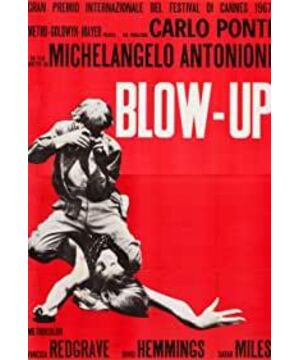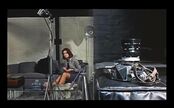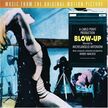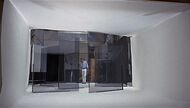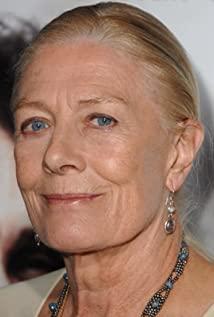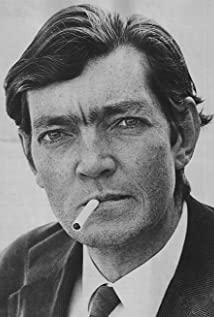"Zoom" is Italian director Michelangelo Antonioni's first English-language film, and it is also the director's proud work to win the Palme d'Or. Most of Michelangelo's early works, including the most famous trilogy of modern love ("Adventures", "Night" and "Eclipse"), are keen to portray the human beings who turn to the passage through the predicament that the subjectivity of modern society cannot be realized. A state of alienation in which love seeks liberation and cannot be freed, these films have earned the director an international reputation. But unlike its predecessors, "Zoom" is seen as the director's challenge to a more contemporary proposition. It discusses the existence of reality, and the basis and meaning of such reality.
1. The camera as a medium
In Zoom in, an important and metaphorically symbolic element is the camera. Whether in the film or in real life, the camera (or the cameraman), as a substitute and representative of the authority of the media, performs the function of examining from the real world, and through a symbolic way, it can capture all possible Objects govern and alienate. In the first half of the film, photographer Thomas is always using the camera to realize his desire to have absolute control over reality. In the English version of the film's official poster, Thomas straddles his legs on a female model. There is an unabashedly aggressive metaphor in this composition, but both the cameraman and the model seem to enjoy the process. Looking at the relationship between the two, we can find that the camera becomes the connection between the real world and the symbolic world: for the model, the camera becomes the sublimation door to the symbolic world, helping her to transcend reality; for the cameraman For Thomas, just like Bresson who always carries a 35mm camera in search of the decisive moment, what he longs for is to use this cold mechanical device to exercise the power to examine and symbolize reality that cannot be avoided or rejected. At the moment of pressing the shutter, the camera and the cameraman behind it jump out of the realm of reality and are deified.
Thomas indulged in the thrill of disengagement and domination of reality, blind to the skepticism that lay before him. His private life was a mess, and he remarked that his wife (who was already having an affair with another man) was easy to get along with, and immediately changed his mind; he never lacked interest in the girls who begged him to take pictures, but he seemed to be more interested in taking pictures than in sex; he and Crazy fans snatch the rock star's guitar and quickly throw it away. With his habitual sneer at most reports, and his rebellious pursuit of many seemingly boring things, he has actually lost the ability to acquire definite meaning. These real-life fogs are exactly the sword of Damocles set by the director for the protagonist (or the audience). Once the positivity of the environment is subverted, the meaning will follow the truth and be cleaned up.
2. The reliability of the mimetic environment
The era when the director of this film was active happened to be the era when the authority of the media was most projected. The popularization of traditional formats such as newspapers has brought the dissemination power of traditional media to a peak, while insufficient technological development has made the media platform scarce and further strengthened its authority. In this case, the domination of reality by the mimetic environment is particularly strong. The cameraman who appears in the film is a metaphor for the mimetic environment disturbing the real world.
People's cognition of the external world must be through the selection, processing and reconstruction of symbolic events or information through media. People tend to regard this selectively reconstructed mimetic environment as an objective environment, or, in other words, people have no choice but to perceive the external world partially in this way. And even our own knowledge, that is, our perception of the existence of the self as a subject, can only be viewed by projecting the self through the projection of the object world. Thus there is always the possibility of fallacies in the cognitive process of the subject (whether it is about the external world or about the self). One of the motifs of Amplification is the fallacy caused by the medium. If you put aside this metaphor, this pivotal masterpiece in film history will even be regarded as a boring work with absurd plot and redundant narrative.
The film's central inconsistency stems from photographs of young couples captured in the park by cameraman Thomas. It was these pictures of Thomas (not the shooter in the grass) that created and erased a homicide. Why do you say this way? We see that Thomas originally just wanted to compile these photos into his new photo album. It was Jane who repeatedly asked Thomas to return the film, which made him suddenly suspicious and decided to enlarge the photo and found clues to the murder. In fact, the so-called clues were so obscure in the original photo that they were still indistinguishable even at high magnification, and were even described by Thomas's wife as an abstract painting drawn by their friend Bill. The clues of the homicide come from such a slim possibility, which inevitably makes people suspect that the director did it on purpose, and the disappearance of the body out of thin air and the almost simile tennis scene undoubtedly confirms our guess. Thomas photographed and verified a corpse out of nothing (because the so-called truth does not know or does not exist, this sentence can also be said to be "a corpse that was photographed and verified disappears out of thin air"), in order to highlight and satirize his objection to the objective The morbidity of believing in and taking pleasure in media authenticity.
Susan Sontag says in her On Photography : "Humankind remains hopelessly in Plato's cave, old habits unbroken, still revelling in images that are not reality itself but only reality." (Humankind lingers unregenerately in Plato's cave, still reveling, its age-old habit, in mere images of the truth. ) At the beginning of the emergence of photography as a medium, what distinguishes it from any other medium is that it directly uses the light in the objective world. Darkness and color are the objects, and the authenticity of the medium can almost be ensured under the insufficient technical level at that time. People who are eager to find absolute credibility thus bypass the authenticity of the interaction between the camera and the self, and directly determine the absolute objectivity of the image. However, in Susan Sontag's view, as long as the filming process takes place, there must be a choice between different time and space and shooting angles, and the photographer can guide or prohibit people from seeing certain truths. Therefore, even if it is a real image, it is still impossible to avoid the disturbance of the media deviation to the real world. Furthermore, according to Saussure's point of view, images belong to the phenomenal domain, and the arbitrariness principle of the signifier cannot be bypassed in the process of projecting from the phenomenal domain to the real domain. The interpretation of the same image is also divided into enlightenment and rigidity, empathy and indifference. A mimetic environment can never be a true projection of reality.
3. Decoupling of positivity and transcendence
The truth and the unreal are the eternal and important propositions of the symbolic system of human society. People take the truth as a transcendental pursuit almost without thinking, and resist the unreal as its opposite. In "Zoom In," Thomas adds significant value to the image, even in his opinion, the female ketones seen through the lens are more alluring than those seen directly. As mentioned above, he is devoted to finding absolute credibility, and is fascinated by the illusion of objectivity in images. But when absolute truth collapsed in front of him, Thomas was engulfed by a huge cognitive dissonance, forced to abandon empirical meaning and plunged into nihilistic confusion. The end result we have all seen: Thomas convinced himself that the non-existent tennis ball disappeared on the de-symbolized real lawn.
For the lost authenticity, the director's solution for Thomas is a total betrayal of the truth. At the end of the film, Thomas achieves a two-way reconciliation between positive emptiness and meaning emptiness by consciously accepting illusion .
Thomas' solution is betrayal, pursuing self-consistency rather than loyalty, which is reminiscent of a villain in "The Matrix" - he was rescued by Zion to the real world but actively asked to return to the false mother world to enjoy Easy life. It's the same as Thomas picking up a tennis ball in Zoom. In the end, it turned out that the inhabitants of Zion were just poor people who thought they lived in the real world, but were actually still living in their mother's body. The inhabitants of Zion cling to their self-imposed objectivity and spurn traitors, but in a bigger picture they appear foolish. This is not just the plight of the people of Zion, but the plight of all of us.
4. Realization of Mimic Environment
Let's go back and revisit the cave allegory, the Matrix, and tennis that doesn't exist. In Plato's allegory of the cave, humans mistake the reflection of the Real (the symbolic element) for the Real itself, and try to implement this framework in various ways (such as throwing old punches at the philosophers who are keen to reveal the truth) . But in fact, people are wrong not because they fail to distinguish between the real and the unreal (because, as Lacan said, the real never existed), but because they fail to distinguish the real domain of the same world and symbolic domains. However, in the metaphorical field of tennis that does not exist, the status of the semiotic domain is reversed: the behavior of the other as a mimetic environment is above the real world and cannot be falsified. In this way, what was originally absurd Void Tennis became the truth, realizing the reality of the mimetic environment. Thomas's deference to this context is not due to his infidelity but to the actual transformation of the environment by the media.
Under the threat of a collapse of meaning, the cameraman himself is forced to accept the inverted subjective reality as the real (or only perceptible) environment. Here, all the others with a media nature, including the behaviors, gazes, and value systems of others, effectively interrogate and even cover the real world that the cameraman originally thought, realizing the reality of the mimetic environment. The cameraman travels back from the void of existentialism to the void of structuralism, abandoning subjectivity and embracing skepticism. What should we say to this David Hemings? To borrow a sentence from Zizek: Welcome to the great desert of the Real!
View more about Blow-Up reviews


